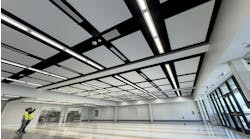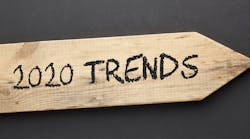Latest from Technology
Sponsored
By Lawrence Smith
At the onset of a new year, most people are thinking of ways to take advantage of a clean slate and make improvements in their lives and work. Faced with ever-changing workflows and tight schedules for projects that are increasingly complex, the time is right for MEP contractors to explore new processes and technologies that can create efficiencies, reduce errors and waste, and streamline construction schedules by saving time, effort and money.
Last year brought tremendous progress as data and technology continued to drastically change and improve the construction industry. From cloud to robotics, 2020 is shaping up to be just as exciting. Here’s a quick look at the top technology and trends that will help MEP contractors work faster and smarter in the year ahead.
• Cloud Collaboration. Modern technology is making it easier than ever to efficiently manage complex, large-scale projects with connected jobsites that leverage cloud-based software, mobile devices and connected systems. With a cloud-based collaboration platform, project teams can share data freely and efficiently, in real-time, between the office and the field. Cloud collaboration ensures that information is easily shared, understood and available throughout the project. With improved visibility, trade teams such as MEP contractors and engineers can coordinate, communicate and collaborate directly.
• Moving Beyond BIM. Traditionally, BIM has been used as a design tool to aid in visualization, providing an interactive and intuitive conceptual model of buildings. Today, the construction industry is on the cusp of a massive transformation in which BIM is no longer enough. The next generation of amazing buildings will require construction professionals to build beyond the limits of BIM using a library of detail-rich data, streamlined workflows and real-time collaboration from the field to the office and back again. Known as the Constructible Process, this purpose-driven approach to building construction is allowing project teams to coordinate and optimize the entire design, build and operate lifecycle with connected, content-enabled and constructible data.
• Constructible Content. Beyond supplying a universal 3D model of each component and its place in the overall plans, constructible content is rich with metadata such as cost, weight, expected performance, sourcing, installation instructions and more. Today, high quality, high-LOD (level of detail) components are built, managed and tested by leading technology providers and available to MEP detailers, estimators and engineers for use in their daily workflows. Constructible content is the digital building block of every project following a Constructible Process. The value of the process itself and the finished product that gets built are dependent on the accuracy and reliability of the content. It’s this rich depth of information that truly gives a 3D model its power.
• Prefabrication. While not new, prefabricated components are gaining acceptance, leading to wider adoption and interest among contractors. The ability to integrate and share accurate data in real-time has made prefabrication more practical and cost-effective. Prefabricating MEP system components in offsite facilities and shipping them to the jobsite for installation can lead to accelerated project schedules, higher quality and more efficient workflows.
• Augmented Reality (AR). IDC forecasts that spending on AR and virtual reality will hit $18.8 billion in 2020. Today, MEP contractors are using AR to visualize complex data and make more informed decisions on the jobsite. Combining the physical and virtual words together, AR superimposes virtual data on a contractor’s physical surroundings. Not only does it provide a way to extend constructible BIM data to the field, AR makes it easy to view spatial relationships more accurately so project teams can identify and mitigate clashes sooner.
• 3D Laser Scanning. Modern 3D laser scanning continues to provide value by informing construction plans and providing valuable as-built data before and during projects. With reality capture software and 3D scanning hardware, contractors can more efficiently and cost effectively identify locations of existing MEP systems. The scan data is then imported into a 3D modeling environment to either create accurate as-built constructible models or inform the design with the real-world conditions.
• Robotics. Autonomous robots can play a significant role in construction, specifically in production and quality control workflows by enabling automation of routine and tedious tasks, reducing workload and improving safety. Robots can be used for routine tasks in hazardous environments to keep humans out of harm’s way. Another interesting use case is in daily review and inspection, saving a site supervisor from doing at least some end-of-day walk-through inspections, while also increasing the consistency of collected data, with pre-planned locations for the robot to carry a sensor such as a laser scanner.
• Internet of Things (IoT). In simple terms, IoT refers to physical devices connected to the Internet that exchange data without human interference. As one of the fastest growing technologies in the world, IoT is finding its way to the MEP industry. With the addition of sensors to generate input and triggers for output, data-rich BIM creates a perfect foundation for IoT. MEP contractors are using IoT for live tracking of progress on jobsites, collecting and visualizing data in a 3D model to see. For example, it can be used to identify where a valve is connected to a pump and to monitor its performance and predict maintenance.
• Artificial Intelligence (AI). It may seem futuristic, but AI is making jobsites safer, more efficient and more productive. AI can track the real-time interactions of workers, machinery and objects on the jobsite and alert supervisors of potential safety issues, construction errors and productivity concerns. AI in the form of generative design is being used to identify and mitigate clashes and prevent rework between the disparate models generated by different teams during planning and design. As the software learns from each project and each design change, it will also generate suggestions for more optimization in future projects.
As we enter a new year and a new era of digital transformation, these technologies and trends make seamless workflows and increased collaboration possible and will continue to move the construction industry toward optimal levels of productivity and efficiency. Which of these will you explore in 2020?
Lawrence Smith is General Manager of the Trimble MEP Division. For more information, visit https://mep.trimble.com.


